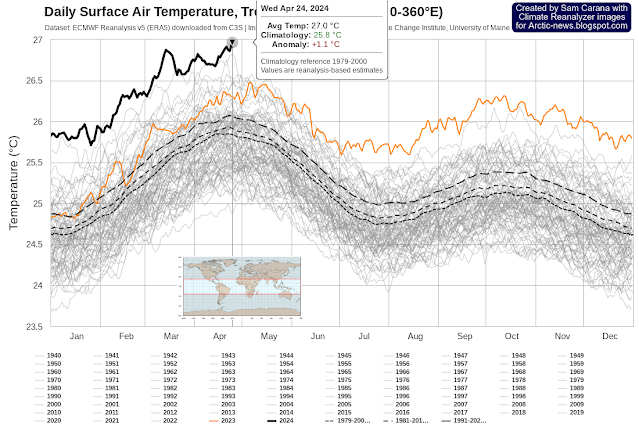by Andrew Glikson
Where “Two plus two equals five if the party says so” (George Orwell)
and when drilling methane wells reduces global warming
Note the future estimates of CO₂ levels.
 |
| [ Figure 1. Historic CO₂, by Owen Mulhern, image from Forster et al. (2017) ] |
 |
| [ Figure 2. by Glen Fergus, from: Wikipedia - Temperature of Planet Earth ] |
The rise in CO₂ in the atmosphere and oceans and the rise in ocean acidity (decline in pH).
 |
| [ Figure 3. As human activities have increased CO2 levels in our atmosphere (red line), about a third of that CO2 has been absorbed by the ocean (green line), and ocean pH has decreased (blue line). Adapted from NOAA by UC Museum of Paleontology. ] |
According to the IPCC, as stated by the late Prof Will Steffen, Australia’s foremost climate scientist, if the exponential rise in greenhouse gas emissions continues we will already have crossed the upper limit that gives us a two-thirds chance of limiting warming to <2.0°C. Other scientists estimate that we have already missed the boat.
During the 200-plus years since the onset of the industrial revolution, the burning of fossil fuels, changing land use and deforestation increased the concentration of atmospheric CO₂. As the ocean absorbs about 30% of the CO₂ its surface acidity increased by -0.1 pH units on a logarithmic scale, resulting in rising concentration of hydrogen ions, a process with far reaching implications for the survival of marine organisms, altering ecosystems.
Ocean acidification affects marine life by dissolving shells and skeletons made from calcium carbonate. Organisms that produce calcium carbonate structures, like corals, sea urchins, sea snails and oysters, need to spend extra energy repairing damaged shells or thickening them to survive.
The onset of the Sixth mass extinction of species.
 |
| [ Figure 4. Cumulative vertebrate species recorded as extinct or extinct in the wild by the IUCN (2012). Dashed black line represents background rate. This is the ‘highly conservative estimate’. Source: Ceballos et al. (2015). ] |
There have been five Mass Extinction events in the history of Earth's biodiversity, all caused by dramatic natural phenomena. The current rate of extinction is 10 to 100 times higher than in any of the previous mass extinctions in the history of Earth. Incorporating estimates of the true number of invertebrate extinctions leads to the conclusion that the rate vastly exceeds the background rate and that we may indeed be witnessing the start of the Sixth Mass Extinction Island species have suffered far greater rates than continental ones.
As systematic biologists, we encourage the nurturing of the innate human appreciation of biodiversity, but we reaffirm the message that the biodiversity that makes our world so fascinating, beautiful and functional is vanishing unnoticed at an unprecedented rate. These estimates reveal an exceptionally rapid loss of biodiversity over the last few centuries, indicating that a sixth mass extinction is already under way.
While multitudes of humanity are trying to escape climate disasters, such as Africa, or are engaged in fatal conflicts and geocidal wars, or are perched in front of electronic screens flaunting obscene hubris, cheap entertainment and commercial and political propaganda.
It is far from clear who, apart from the children, would be able to save life on Earth?
Earth and climate scientist
Books:
The Asteroid Impact Connection of Planetary Evolution
https://www.springer.com/gp/book/9789400763272
The Archaean: Geological and Geochemical Windows into the Early Earth
https://www.springer.com/gp/book/9783319079073
The Plutocene: Blueprints for a Post-Anthropocene Greenhouse Earth
https://www.springer.com/gp/book/9783319572369
The Event Horizon: Homo Prometheus and the Climate Catastrophe
https://www.springer.com/gp/book/9783030547332
Climate, Fire and Human Evolution: The Deep Time Dimensions of the Anthropocene
https://www.springer.com/gp/book/9783319225111
Evolution of the Atmosphere, Fire and the Anthropocene Climate Event Horizon
https://www.springer.com/gp/book/9789400773318
From Stars to Brains: Milestones in the Planetary Evolution of Life and Intelligence
https://www.springer.com/us/book/9783030106027
Asteroids Impacts, Crustal Evolution and Related Mineral Systems with Special Reference to Australia
https://www.springer.com/us/book/9783319745442
The Fatal Species: From Warlike Primates to Planetary Mass Extinction
https://www.springer.com/gp/book/9783030754679
The Trials of Gaia. Milestones in the evolution of Earth with reference to the Antropocene
https://www.amazon.com.au/Trials-Gaia-Milestones-Evolution-Anthropocene/dp/3031237080





.png)
















